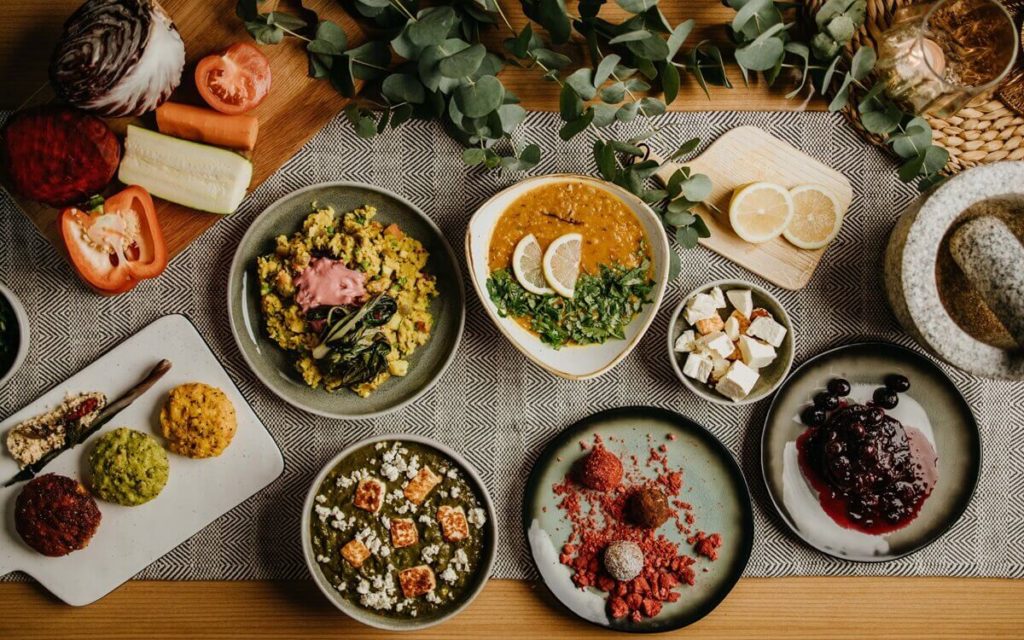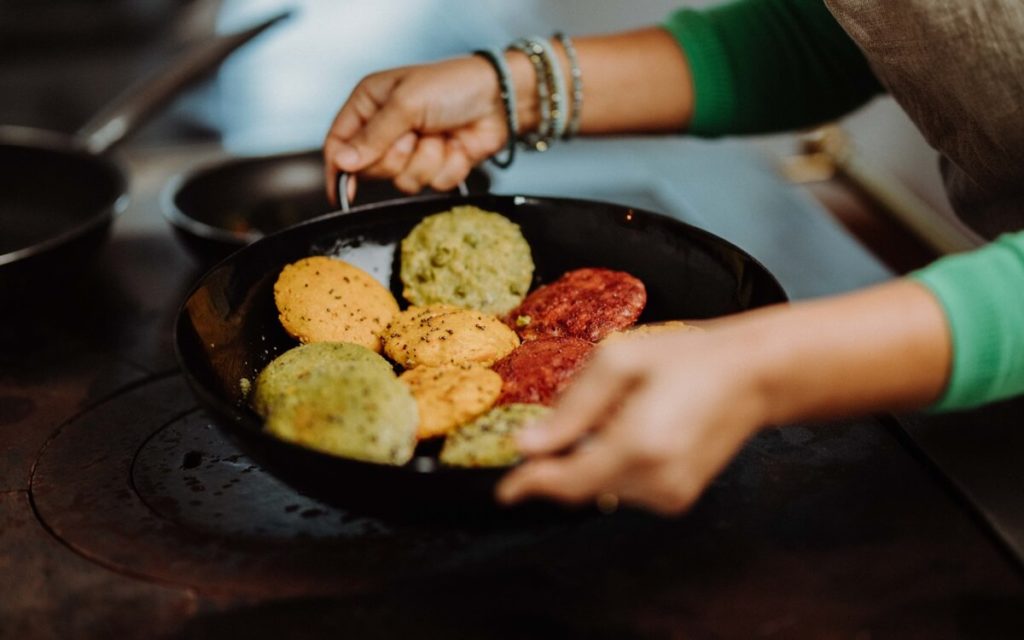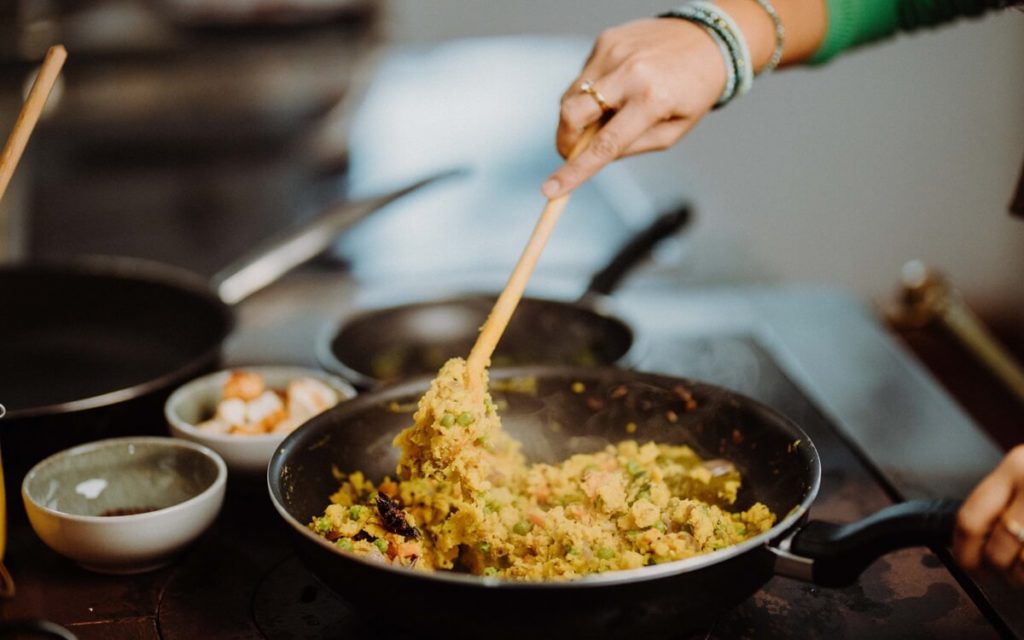The Ayurvedic diet is based on 5,000 years of Indian medicine and describes a complete system of nutrition. It involves combining foods in such a way that they are compatible with each other. In this article, you will learn all about the characteristics and basics of Ayurvedic nutrition.
The Ayurvedic diet
We live in a hectic world in which food no longer serves to nourish, but only to satiate. Food of non-organic origin is also heavily treated. The Ayurvedic diet is the counterpart to this with conscious enjoyment, unprocessed foods and local products.
An Ayurvedic diet carefully considers all the treasures that nature gives us. Your physical and mental needs are individually taken into account in your diet. The food not only gives you valuable vital energy, but also nourishes your physical health, your soul and your spirit.


Ayurvedic nutrition combines effective nutritional therapy with creative cooking. The fresh foods are selected to suit your constitutional type. The times of day and seasons are also taken into account and thus specifically tailored to your metabolism.
The dishes are refined with Ayurvedic herbs and spices. These give the dishes a varied taste and have a positive effect on the human organism. With the right diet, you can therefore positively influence and boost your energy.


Ayurveda cookbook for at home
Discover the cookbook "Es geht mir richtig gut mit Ayurveda" for at home - with 60 simple and healthy recipes from the European Ayurveda Resort Sonnhof!
Our head chef: Leonard Müller
With European Ayurveda cuisine, the principles of the Indian art of healing are transferred to the taste of our home latitudes. At the European Ayurveda Resort Sonnhof , we only use fresh organic food from the region. Our Ayurvedic cuisine is meat-free in order to actively relieve your body as soon as you start eating.


We have been recognized as a "Vegan Welcome Hotel" by the global cooperation Vegan Welcome for our healthy and ethically responsible lifestyle. For our guests, this means that a vegan option is offered at every meal. We are delighted that our European Ayurveda concept has received so much regional and international recognition.
Guiding principles of Ayurvedic nutrition
The Ayurvedic diet is above all one thing, namely type-appropriate. Your nutritionist will recommend a diet based on your individual constitution and its disorders. A distinction is made between mental, emotional and physical effects. Your diet is aimed at the renewal and healing of your body as well as your personal development.
Ayurvedic nutrition is also suitable for everyday life and can be easily integrated into your daily life. Your lifestyle and the cycles of life are taken into account when creating the rules and recipes. The ingredients are selected according to the phases of life, seasons and times of day.
Ayurvedic cooking is undogmatic and imaginative. The dishes are prepared differently depending on taste and culture. This makes the dishes tasty and sensually fulfilling at the same time. Nutrition is medicine and will promote the healing process through special diets and cures according to your state of health.
| Origin | I do feel really good. Because I get to eat fresh, nutritious, high quality food. I pay attention to the origin and enjoy unprocessed products. |
| Atmosphere | I do feel really good. Because I get to eat in a calm and pleasant atmosphere. I pay attention to a harmonious environment when I cook and enjoy. |
| Preparation | I do feel really good. Because my body can use all the nutrients optimally and digest the food well. I pay attention to a preparation that brings my three doshas into balance. |
| Time | I do feel really good. Because I adjust my diet to the time of year, time of day, and phase of my life. I make sure to enjoy my food without stress. |
| Quantity | I do feel really good. Because I listen to my natural sense of satiety and can distinguish between emotional and physical hunger. I make sure that I don't overeat. |
| Taste | I do feel really good. Because I eat a balanced diet and it just tastes good. I make sure that all six flavours are present in my food. |
| Combination | I do feel really good. Because my body can digest the food properly. I pay attention to an idal combination of foods. |
The cuisine at our Ayurveda resort: Tridosha
Regional, conscious, wholesome. The diet at the European Ayurveda Resort Sonnhof is characterized by appreciation and mindfulness. The philosophy of Indian healing teachings is adapted to regional products and the taste buds of the Western world. Taste the difference: fresh and organic food from the family farm in delicious Tridosha dishes.


In the morning, enjoy a generous breakfast buffet that combines local and Ayurvedic specialties. At lunchtime, you can help yourself to the pitta buffet: Warming soups, colorful salads, nourishing starters and delicious desserts. In the afternoon, indulge in a Vata snack with a tea ceremony and healthy delicacies. In the evening, you can choose between Ayurvedic, fish or vegan dishes.
Experience a wonderful symbiosis of fresh vegetables, invigorating herbs and delicious meals. If you enjoy an Ayurveda cure with us, your Ayurveda specialist will explain to you exactly what you can enjoy at each meal. For pure moments of pleasure that have a lasting positive effect on you and your soul.
10 basic rules of Ayurveda nutrition
Ayurveda has a large catalog for individual constitutional and metabolic balancing. There are also some basic rules that you should take into account in your diet. This will promote your long-term health and increase your performance.


The following 10 dietary rules will help you to balance your individual doshas and optimize your digestion. The rules can be easily integrated into your daily diet. They can therefore also be used specifically as part of a nutritional therapy diet.
The right amount
Part of Ayurvedic eating is to eat in moderation, as both too much and too little food can lead to disorders. Imagine the capacity of your stomach divided into quarters: Two parts are for solid food and one part for liquid food. The fourth part should ideally remain free so as not to disrupt the digestive functions.
Do not drink with meals
So that you don't put out your digestive fire, you shouldn 't drink anything before and after eating. It is advisable not to drink anything during the meal or only very little to aid your digestion. Another exception is teas to stimulate digestion before eating. Generally speaking, still or warm water and herbal teas are best suited for fluid intake.
Eat high-quality food
Make sure the food is as pure as possible - i.e. high-quality, fresh - and prepared with love. The best quality is usually offered by home-grown produce and organic food stores, as hardly any fertilizers, insecticides or harmful substances are used in these products. You should also prioritize regional and seasonal food.
Prefer cooked and home-prepared meals
It is best to cook for yourself and eat warm meals in particular. The heat stimulates your digestion and metabolism. This means that even meals that are difficult to digest can be broken down and utilized better. In particular, you should prepare your main meals at lunchtime and in the evening warm.


Individuality in food selection and preparation
Consider your personal preferences and intolerances when choosing food. Take your constitution (Prakriti) and possible current health problems (Vikriti) into account.
Eat in peace and chew well
Slow eating and conscious chewing not only allow you to enjoy your food more. You also relieve your stomach and intestines of a lot of work and make an important contribution to healthy digestion.
Eat in a pleasant atmosphere
The mental component plays an important role in the intake of food. Enjoy your food in a place where you feel safe and comfortable so that you can devote your full attention to the process of eating. Avoid distractions such as reading, talking or watching TV. This can negatively affect your digestion and your health in the long term.
Eat regularly and avoid snacks in between meals
Eat regularly and avoid uncontrolled snacks. It is best not to eat again until the previous meal has been digested. This is the only way to avoid stressing your digestive and metabolic processes. The food you eat in the morning and at lunchtime should be digested by the evening and dinner by the next morning.
- Digestive function is sluggish in the morning: small and light breakfast
- Digestive power is strongest at lunchtime: main meal
- In the evening about three hours before going to bed: light, warm meals
Ensure a balanced taste
In Ayurveda, a meal is considered balanced if it contains all six flavors. Ideally, you should eat them in the following order: sweet, sour, salty, spicy, bitter and finally tart. This order corresponds to the phases of digestion. Cooking with ghee (butter fat) also intensifies the taste and aids digestion.


Pay attention to the right combination
When preparing your dishes, pay attention to the correct combination of the individual components. Certain foods should not be combined with each other. These "wrong combinations" are considered to cause various illnesses. The consequences can be an inadequate transport function or "contaminated" blood.
- Never consume milk together with sour and salty foods, meat, fish, garlic, radish, pomegranates, leafy vegetables, mustard, sesame seeds, basil or bananas.
- Milk-friendly, on the other hand, are: Mango, grapes, honey, ghee, butter, ginger, pepper, sugar, rice flakes, barley and the Amla fruit (Emblica officinalis).
- Meat should not be combined with honey, sesame, milk, radish, sugar cane products or sprouts. This would lead to various nerve disorders.
- Do not combine fish with banana, milk, yogurt and buttermilk.
- It is best not to combine fresh fruit with cooked food.
- Do not eat sour fruit with yogurt or cheese.


Discover healthy Ayurveda foods
Discover delicious and healthy Ayurveda foods in the European Ayurveda®Shop now!
Nutrition tips for balancing the doshas
You can find out what effects your diet has on the balance of the doshas in the following section. With the right diet, you can strengthen the energies in your body and prevent illness.


Your Vata diet
You can calm your Vata with this type of diet. It is important to choose foods that are the opposite of Vata in order to balance its properties. Make sure you eat a regular, warm diet consisting mainly of liquid, oily and heavy dishes. Feel how your Agni (digestive fire) is strengthened and your sensory organs are invigorated.
Your Pitta diet
Pitta nutrition is right for you if you want to calm or reduce your pitta dosha. Make sure your diet is the opposite of this. Pitta is found in hot, liquid, sour, spicy and light dishes. Enjoy four small meals a day, where you are welcome to eat raw vegetables and cool foods. Feel how your body deacidifies and your blood is cleansed.
Your Kapha diet
Kapha has a cool, heavy, stable, oily effect and is perfect if you want to pacify this dosha. You are welcome to fast regularly or skip meals from time to time. Pay particular attention to a warm and light diet in small portions with a high vegetable content. Feel how blockages are released and your metabolism is stimulated.
Your Tridosha diet
With the Tridosha diet, your doshas are balanced in equal parts. Or you have a family that combines Vata, Pitta and Kapha. Tridosha nutrition encompasses the entire Ayurvedic diet and you can enjoy it as you wish. If you like, you can orient yourself seasonally to the individual doshas.
Vata in fall and winter, Kapha in spring and summer and Pitta in midsummer. Pay particular attention to high-quality, regional and seasonal foods and a balanced diet. Feel how you stay in balance and how your body gets through the seasons with more serenity.
Recognize your Ayurveda nutrition type
The following questionnaire consists of several parts and helps you to determine your Ayurveda nutrition type.


- Vata, Pitta or Kapha?
The current state (vikriti) of your doshas is crucial for type-appropriate nutrition. Through the correct selection and preparation of food, they are brought into balance according to the principle of "opposites balance each other out". The aim is to soothe pronounced characteristics through proper nutrition.
If the qualities listed in the table are strongly pronounced on a physical or mental level, they indicate the imbalance of one or more doshas. You can balance these out with foods of the opposite quality.
| Vata | Pitta | Kapha |
| light dry cold rough sensitive flatulent changeable |
acidic hot reddened burning sharp inflammatory penetrating irritated |
heavy moist immobile listless slimy sweet tissue-building oily |
| Vata properties: ___ | Pitta properties: ___ | Kapha properties: ___ |
- Appetite and digestive capacity
The guiding principle of Ayurvedic nutrition is "You are what you digest". According to the type-appropriate quality of the metabolism (Agni), the type-appropriate diet is based on the right quantity, choice of food and spices during meals.
| Vata | Pitta | Kapha |
| Flatulence Dry stools Frequent constipation Sometimes diarrhea Loses weight easily |
Strong appetite Heartburn Burning stomach Diarrhea Yellowish, loose stools Active metabolism |
Moderate appetite Often eats too much Feeling of fullness Greasy stools Slow digestion Gains weight easily |
| Vata properties: ___ | Pitta properties: ___ | Kapha properties: ___ |
- Dosha disorders and tendencies to illness
Are you particularly prone to some of the following complaints? Counteract this with a type-appropriate diet.
| Vata | Pitta | Kapha |
| Sleep disorders Anxiety, Worries, Nervousness Underweight, emaciation Immunodeficiency Ringing in the ears or tinnitus Frequent pain, Stiffness and cramps Musculoskeletal complaints, Neurological diseases |
Fever, excessive sweating emotional irritability and aggression inflammation and suppuration headaches, migraines blemished skin, skin diseases weakening of eyesight premature hair loss and/or graying of hair |
Water retention, Oedema Excessive mucus formation in the bronchi, forehead, sinuses Feeling of heaviness in the body, Overweight, Obesity Drowsiness, Excessive sleep Diabetes Tumor formation |
| Vata properties: ___ | Pitta properties: ___ | Kapha properties: ___ |
Evaluation of the Ayurveda nutritional types
Add up how high the results of your respective answers are for each dosha. If there is a particularly high total for one or two doshas, you should take the following tips to heart.
Nutrition to balance Vata
- Three warm and cooked meals a day are just right for you, also prepared as a stew
- Give preference to warm, cooked, nourishing and easily digestible foods with a sweet taste component. Particularly well tolerated are: Root vegetables, nuts, cereal flakes, stewed sweet fruit, butter and cream
- Only eat small amounts of hard-to-digest foods such as raw vegetables, cabbage and pulses
- Cook with digestive spices such as ginger, cumin, hing (asafoetida), fennel, cinnamon and aniseed
- Make sure you eat regularly and in a calm and relaxed atmosphere
- Prefer warm drinks and drink one or two cups of warm ginger water in the morning
Pitta balancing diet
- Eat your main meal at lunchtime, when the digestive fire (Agni) is at its highest
- Avoid acidic, spicy and heating foods such as citrus fruits, sour berries, vinegar, tomatoes, salt, alcohol, red meat, acidic dairy products and hot spices as much as possible
- Favor sweet and bitter vegetables such as leafy greens and root vegetables and try to include a large portion of salad and/or raw vegetables in your diet every day
- Lots of sport and exercise helps you to physically and mentally "release pressure"
- When cooking, use spices that balance the digestive fire, such as turmeric, coriander, fennel, cardamom and fresh garden herbs
Nutrition to balance Kapha
- Don't overload your stomach and avoid snacks in between meals
- Don't eat your last meal too late in the evening and avoid all cold, raw, heavy and slimy foods. This includes cheese, raw vegetables, meat and dairy products. Soups or stews are ideal
- Stimulate your digestive fire with hot spices and bitter herbs: Chili, pepper, ginger, cress and chives are particularly good for this
- Make sure you get regular exercise and exercise in the fresh air to boost your metabolism and gain more lightness
- Drink one to two cups of hot water or ginger water with a little honey every day


Ayurvedic detox: procedure and effectiveness of Ayurvedic detoxification
In our hectic and fast-paced world, there is often no time for healthy and wholesome food. A healthy diet is often neglected. With an Ayurveda detox cure, your body is detoxified, your soul can breathe a sigh of relief and your mind can concentrate on the essentials again.






